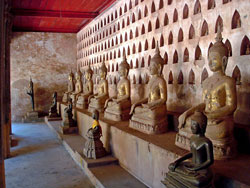Wat Siskaket (Wat Sisaketsata Sahatsaham) is Vientiane's oldest surviving monastery. Built in 1818, during the reign of King Anou, Wat Sisaket is one of only a few buildings in town not sacked by the Siamese in 1827. Not by origin but in its present construction, it is also the oldest building in town.

What To See
The inner sanctury contains an extensive displays of Buddha images from the 16th to the 19th century - 6840 such images. The grounds are richly planted with a variety of vegetation that is lovingly tended, so it becomes a restful retreat as well.
The main feature of the temple is a roughly square cloister that encloses the "sima" (ordination hall). This is a common feature of large Thai temples, but is less common in Lao temples. An unusual feature in any temple is the thousands of small niches in the outer wall, each of which houses a small Buddha image.
On shelves in front of the wall are three rows of larger Buddha images, in various styles and materials. In a converted entrance portico west side of the cloister is a sort of "Buddha bin" holing hundreds of broken images discovered during excavations in support of one of the restorations.
An outer gallery is lined with inward leaning 12-cornered columns, topped by elaborately carved wooden brackets and fretwork. Inside the hall, the walls are painted at eye level with scenes from the jataka, a series of stories about the past lives of the Buddha. The life illustrated is an unusual choice. It is the story of Prince Pookkharabat, who appointed an "honest thief" as chief minister and defeated enemy armies with the assistance of a magic fan. The murals are badly deteriorating. Above the murals are more small niches holding Buddha images.
West of the cloister, straddling the outer wall of the temple, is the former library where the palm leaf manuscripts documenting Buddhist philosophy were once held. The square building houses a massive cabinet that once held the books. Although now faded, the cabinet was once finished in black lacquer with delicate golden designs. Behind the library, between the wall of the cloister and the outer wall of the temple, is a dirt path lined with small stupa containing the ashes of cremated temple devotees.
Although it is ostensibly a museum, Wat Sisaket is still a working monastery, with several monks and novices in residence.



